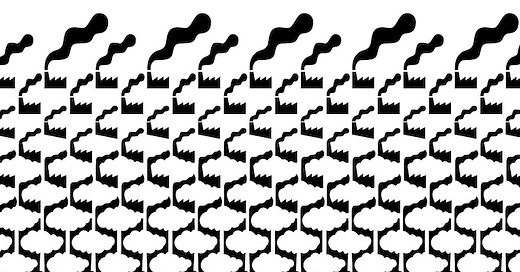#32: Why Trump’s Tariffs Are a Green Opportunity for Chinese Aluminum
Decarbonizing aluminum offers China a win-win solution for the climate crisis and geopolitical uncertainties.
In this week’s newsletter, Yunyou Chen, a research analyst from HK-based nonprofit TransitionAsia, shares her thoughts on decarbonizing China’s aluminum sector.
Not every cloud has a silver lining – but Trump’s recent tariff hike on Chinese aluminum products, combined with the rollout of carbon border adjustment mechanisms in other major export markets, has created a strong financial incentive for this energy-intensive industry to accelerate its long-overdue green transition. Constant concerns over the security of raw material supplies only add to the urgency, pushing the sector to fast-track its shift in production processes. By tapping into China’s extensive non-ferrous metal recycling system, the industry can adopt shorter, lower-emission production routes based on recycled scrap.
China’s primary aluminum production emits more CO2 than the entire country of Indonesia. Chinese regulators have long classified aluminum manufacturing as a “dual-high” sector – high in energy consumption and emissions – alongside coal power, steel, and chemicals. Over the past decade, the sector has relied on the abundant, low-cost hydropower in China’s southwest to reduce its energy and carbon footprints. However, as Yunyou cautions, hydropower – once seen as a quick fix for the sector’s emissions problem – is no longer a reliable long-term solution.
To seize this decarbonization window, the sector must address the elephant in the room: its heavy dependence on outdated, inefficient, and often small-scale captive coal power plants. Built mostly in the early 2000s, these plants have long provided aluminum producers with cheap and stable electricity – but at a significant environmental cost. As Yunyou argues, phasing out the least efficient captive plants and retrofitting some for greater efficiency and flexibility could immediately curb the sector’s rising emissions and stay on track with China’s national carbon peaking goals.
I hope you enjoy this edition of the newsletter. If you’d like to write for us, drop us an email at contact@shuangtan.me.
Analysis: Why Trump’s Tariffs Are a Green Opportunity for Chinese Aluminum
Decarbonizing aluminum offers China a win-win solution for the climate crisis and geopolitical uncertainties.
By Yunyou Chen
Edited by Hongqiao Liu and Kevin Schoenmakers
China’s aluminum industry has a tariff problem. The country produces 60% of the world’s primary aluminum and is the world’s largest exporter of aluminum products. According to custom data, about 15% of those exports are going to the U.S. But, the recent U.S. tariff hike puts a steep 25% tariff on Chinese aluminum.
Moreover, the industry’s heavy reliance on imported bauxite – its key raw material – leaves it vulnerable to trade disruptions. China’s aluminum industry used to source mainly from Malaysia and Indonesia, but after those countries banned mining and restricted exports, it now predominantly sources from Guinea and Australia. Any supply interruptions would cause significant economic damage to the many industries in China that use aluminum for their products.
Decarbonizing the aluminum industry would not only contribute to China’s dual carbon climate goals but also minimize the climate impact of clean energy products that use aluminum.
However, these geopolitical tensions also present an opportunity. The aluminum industry is carbon-intensive, emitting around 5% of the country’s total greenhouse gases. China has yet to establish an official decarbonization roadmap for the aluminum sector, but experts from the Non-Ferrous Metal Association optimistically anticipate that carbon emissions will peak this year. Decarbonizing the sector would not only contribute to China’s dual carbon climate goals but also minimize the climate impact of clean energy products that use aluminum, such as solar and wind power plants, transmission and distribution grids, and electric vehicles.
China could turn the American tariff challenge into a green opportunity. The new import barriers will reshape global trade flows, and allow the Chinese aluminum sector to redirect its trade with the U.S. to more climate-conscious markets.
China could turn the American tariff challenge into a green opportunity. The new import barriers will reshape global trade flows, and allow the Chinese aluminum sector to redirect its trade with the U.S. to more climate-conscious markets such as Australia, the U.K., and Southeast Asian countries. These are among China’s top destinations for aluminum products today and also have mechanisms favorable to decarbonization. For instance, Australia is reviewing the feasibility of a Carbon Border Adjustment Mechanism (CBAM), Thailand is drafting a climate change bill incorporating CBAM, and the U.K. plans to implement its own CBAM by 2027. These emerging carbon border policies, which impose levies on products with high carbon footprints, could incentivize Chinese aluminum companies to continue lowering their emissions.
Support Shuang Tan
Shuang Tan is an independent initiative dedicated to tracking China’s energy transition and decarbonization.
The newsletter is curated, written, and edited by Hongqiao Liu, with additional editing by Kevin Schoenmakers.
One way to cut emissions would be shifting to more circular production processes that use recycled scrap. This would also allow the Chinese aluminum sector to reduce its dependence on imported bauxite. Scrap-based aluminum making – or secondary aluminum production – avoids energy-intensive processes such as alumina refining and aluminum smelting, and could lower emissions by over 95%.
There is a growing supply of recyclable resources. China is experiencing a surge in end-of-life vehicles and building materials such as aluminum facades, roofs, and doors. Yet, recycling capacity remains insufficient to fully tap into this potential. As a result, despite the abundance of scrap and its substantial emissions savings potential, recycled aluminum still accounts for less than 30% of total input.
Phasing out captive coal, repurposing plants for backup and grid flexibility, or replacing them with onsite renewables could yield major emissions cuts.
Apart from shifting to a more circular aluminum production process, China’s aluminum sector must cut its reliance on coal. Smelting, which consumes 7% of the nation’s electricity, relies on coal for 70% of its power supply – 12 percentage points higher than the national average.
Today, many Chinese aluminum companies operate their own so-called captive coal plants to power their smelting facilities. Their total capacity is 80 GW, or 6% of China’s total installed coal power capacity. In top-producing provinces like Shandong, Xinjiang, and Inner Mongolia, smelters rely almost entirely on these captive plants. Despite ongoing retrofit efforts, over half of this capacity still runs on inefficient subcritical combustion and often lacks basic emission controls like dust removal, desulfurization, or denitrification.
Phasing out captive coal, repurposing plants for backup and grid flexibility, or replacing them with onsite renewables could yield major emissions cuts. According to Transition Asia’s estimates, captive coal plants accounted for nearly 75% of aluminum smelting’s electricity-related emissions in 2021. Without deep retrofits or fuel switching, the emissions from these plants could not peak for another 15 to 20 years, even as the sector achieves carbon footprint reductions elsewhere.
In response to China’s strict dual-control policy aimed at reducing energy use and intensity, many aluminum smelters have relocated to Yunnan over the past decade, attracted by its cheaper and cleaner hydropower. China Hongqiao Group, the country’s second-largest aluminum producer, has moved over 60% of its smelting capacity there. However, hydropower is no longer a reliable long-term decarbonization solution for the sector. Climate change-driven droughts have increasingly disrupted production, as the reduced hydropower output is prioritized to meet essential public needs, such as residential and agricultural use.
Hydropower is no longer a reliable long-term decarbonization solution for the sector. Climate change-driven droughts have increasingly disrupted production.
Looking ahead, stronger policy signals can further accelerate the aluminum industry’s green transition. In recent years, China has introduced measures aimed at cutting emissions, improving energy efficiency, and promoting cleaner energy use in aluminum production. The National Development and Reform Commission – the state planner – has set minimum green electricity usage targets for aluminum smelting by province for 2024 and 2025.
Stricter environmental regulations are also raising the cost of coal-fired power, incentivizing smelters to seek cleaner and more affordable power sources and reduce their consumption. For instance, the tiered electricity pricing system introduced in 2013 imposed higher electricity rates on companies, such as smelters, with higher electricity intensity.
China’s power sector Emissions Trading System (ETS) already covers most captive coal plants, and the recent inclusion of the aluminum sector signals growing carbon costs, particularly for small and outdated smelters. However, to become a true game-changer, the ETS must evolve to reward low-carbon producers and penalize high-carbon ones, setting stricter benchmarks, and moving toward an auction based system for allowances.
China’s abundant green resources and rapidly-evolving green technologies present significant decarbonization opportunities for the aluminium sector. Perhaps the current international trade turbulence could be the push it needs to adopt them.
Get in touch
I hope you enjoy this newsletter. Share your thoughts in the comments.
If you’d like to write for Shuang Tan, republish our articles, or submit a testimonial, email us at contact@shuangtan.me.
Until next week,
Hongqiao






